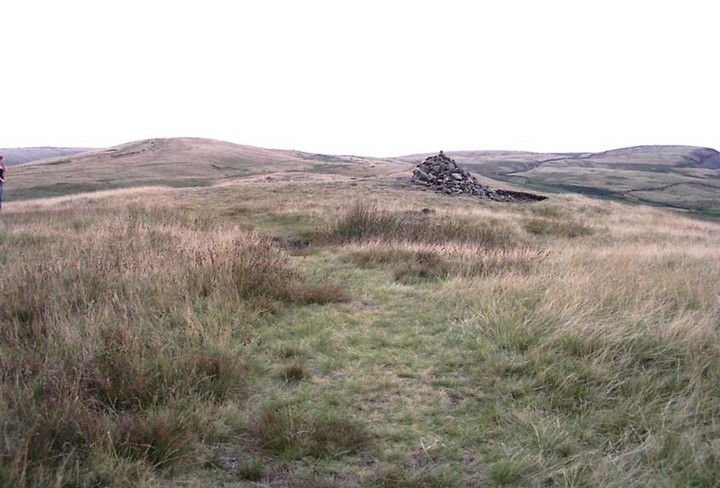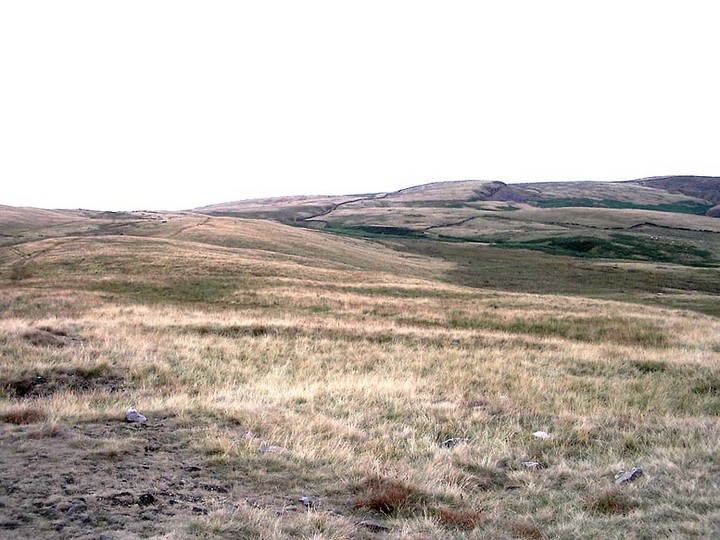‘Cairn’: OS Grid Reference – SD 778 390
Park up at the Nick of Pendle and follow directions to the Devil’s Apronful of Stones, but about halfway along the path, bear to the right along a swerving footpath which eventually takes you to another guiding cairn. On the OS-maps there’s the Chartist’s Well 100 yards due west of this old overgrown tomb.
Archaeology & History

Seemingly excluded from all previous archaeological surveys, this is a very large structure indeed. Crowned with a small modern cairn on its top marking a small footpath crossing the site, this very large cairn-like structure is about four feet tall at the highest. I first came across it at the end of August, 2006, after going through some folklore records which then led to exploring the area in the hope that there might be some archaeological ruins in the region — and we weren’t to be disappointed!

This giant cairn structure is larger than the denuded remains of the Devil’s Apronful cairn that can be seen a few hundred yards further uphill, but is almost entirely overgrown with grasses. It measures at least 31 yards (east-west) by 29 yards (north-south) and is just like an overgrown Little Skirtful of Stones on Burley Moor. Parts of its eastern side have been dislodged and the main rock structure is plainly visible where the vegetation has come away. A ringed embankment is also very clear, mainly on the north and eastern sides of this large structure (as one of the photos here shows), but on the whole it is overgrown and ruinous. It’s a brilliant spot though and sorely needs some proper archaeological attention. In the event that this site aint a prehistoric cairn, please lemme know so I can delete it from TNA.
© Paul Bennett, The Northern Antiquarian
This cairn was built by local unemployed Sabden men during August i926. A 15ft tower was built on substantial foundations to furnish evidence of their skill as dry-wallers.
REF: Blackburn Ref Library ‘Pendle General History’ 07.08.26 PG (with good photo by Pye of Clitheroe)
Other structures have been raised here during the 19C Chartist’s riots – see Bennett’s ‘History of Burnley’ 1949.
One fine sunny morning of July 1926 the people of Sabden awoke to be greeted by the appearance of a large tower above Churn Clough on Pendle Hill. For several weeks the tower excited considerable curiosity not only in the Pendle village itself, but throughout the Ribble and Calder valleys. From distant points the tower resembled a small factory chimney, and its growth was followed with much interest. Inquiries at the time revealed that the substantial foundations of the solid tower were prepared by a Sabden man, and in his absence four other local men carried out the work of building the tower. The men were ‘on the dole’, and, finding time hanging heavily, determined to erect a landmark that could be seen from miles around. The tower was raised, furnishing evidence of their skill as dry-wallers. When the tower had grown to an imposing 15ft., a credit to the men’s industry and ability, lackeys of the Huntroyde and Downham Estates, ‘owners’ of Pendle Hill, undertook the cowardly act of shattering the tower on the first Sunday of August when the dry-wallers were attending Sunday service at their places of worship. Over the coming days the structure was reduced to a pile of scattered stones. One of the builders who climbed the hill to view the wreckage some time later declared “Evidently our work was not appreciated, and we shall have to leave it at that.”
This was not the first time that structures had been erected on this spot. During the mid-19th century Chartist Working Class Rebellion against State terrorism and tyranny (the State/English Establishment then, as now, wanted to reduce the common peoples lot to that of tied slaves to a system of mass exploitation of human and natural resources for the sole benefit of their, and their industrial counterparts, own dynasties) Pendle Hill was used as a foci and rallying point for the forces of humanity.
Feargus O’Connor, radical leader of the Chartist Movement, addressed many meetings in the Lancashire cotton towns and gained great support for his position to “place all classes of society in possession of equal political and social rights.” The State’s reply to this just request was to use unemployment, hunger, starvation, extreme violence and murder to maintain the status quo. These un-human methods employed by the Establishment forced the common people to rise up in arms and fight not only for their freedom but for their very lives. The Padiham Chartist Association’s had on its banner the words “Sell thy garment and buy a sword.”
The earliest record of a Chartist muster on Pendle deals with a meeting on June 12th, 1842, when a gathering of over 2,500 men, women and children of the working class assembled “on the Sabden side of Pendle Hill”. Hustings, made of earth and stones, were hurriedly thrown up and local leader William Beesley addressed the crowd on methods required to address State wrongdoing. The main method advocated was to “seize the land and use it for the need”. Two days later Feargus O’Connor himself addressed a meeting of over 25,000 unemployed working class people from towns and villages around Pendle, the outcome of this meeting was that the unemployed cotton workers went out into the rural areas of Pendle and staked their claims to the land. Needless to say the ‘Iron Heel’ of the State, backed by military and civil forces, came down with a thud and crunch and the common people led off to face the Industrial Holocaust, with its aftermath their kinfolk face today Today’s urban Allotment Associations owe their origins to this period of British human history, being the only thing of good to survive. Perhaps there is a lesson to be learned there for the now – ‘give homage only to Mother Earth’ and develop Permaculture Communities, as against ‘societies’ based on ‘wants’ that lead only to the destruction of life forms.
Today only a small cairn of stones stands as testimony to these historical events of human struggle. Yet the careful eye will discern a 30 yd. dia. ringed embankment that marks the foundations of the 1926 ‘Pendle People’s Tower’ built on and from the debris of Chartist’s platforms.
A path down to the left (NE) of the cairn leads to Chartist’s Well